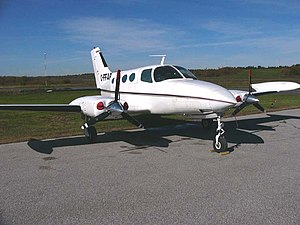Cessna 402
| Cessna 401 & 402 | |
|---|---|
 |
|
| 1967 model Cessna 402 | |
| Role | Corporate transport and airliner |
| National origin | United States |
| Manufacturer | Cessna |
| First flight | 26 August 1965 |
| Introduction | 1967 |
| Primary user | Cape Air |
| Produced | 1966–1985 |
| Developed from | Cessna 411 |
The Cessna 401 and 402 are series of 6 to 10 seat, light twin, piston engine aircraft. This line was manufactured by Cessna from 1966 to 1985 under the name Utiliner and Businessliner. All seats are easily removable so that the aircraft can be used in an all-cargo configuration. Neither the Cessna 401 nor the 402 were pressurized, nor were they particularly fast for the installed horsepower. Instead, Cessna intended them to be inexpensive to purchase and operate.
The Cessna 401 and 402 were developments of the Cessna 411. All 401s and 402s are powered by 300 hp (224 kW) turbocharged Continental engines with three-bladed, constant speed, fully feathering propellers. On later models cruise power was limited to 75% to reduce cabin noise. Some aircraft have a propeller synchrophaser to reduce cabin noise and vibration.
The Cessna 401s, 402s, 402As and some 402Bs built from 1966 to 1971 had four small oval windows, which gave the aircraft a similar appearance to the pressurized Cessna 340. Starting halfway through the production of the Cessna 402B the window configuration was changed to the more distinctive five rectangular windows, an arrangement that was retained through the 402C model, until the completion of production in 1987. All 402Bs were equipped with tip-tanks.
In 1969, American Jet Industries began work on a turboprop-powered conversion of the Cessna 402, named the Turbo Star 402, using Allison 250-B17 engines. The prototype flew on 10 June 1970. Further modifications providing increased fuel tankage, higher gross weight, and lower minimum control speed were carried out in 1974 and the modification was recertificated.Scenic Airlines of Las Vegas purchased the rights to the design in 1977.
The Cessna 402C may be outfitted with vortex generators to increase maximum allowable takeoff weight to 7,210 lb (3,270 kg), with a zero-fuel weight of 6,750 lb (3,062 kg).
...
Wikipedia
